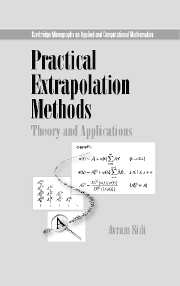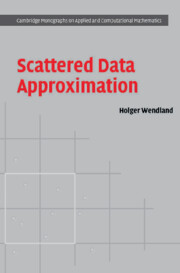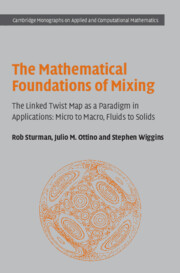Refine search
Actions for selected content:
2584 results in Computational Science

Practical Extrapolation Methods
- Theory and Applications
-
- Published online:
- 25 February 2010
- Print publication:
- 05 June 2003

Scattered Data Approximation
-
- Published online:
- 22 February 2010
- Print publication:
- 13 December 2004

The Mathematical Foundations of Mixing
- The Linked Twist Map as a Paradigm in Applications: Micro to Macro, Fluids to Solids
-
- Published online:
- 03 February 2010
- Print publication:
- 21 September 2006
Computing Modular Polynomials
-
- Journal:
- LMS Journal of Computation and Mathematics / Volume 8 / 2005
- Published online by Cambridge University Press:
- 01 February 2010, pp. 195-204
-
- Article
-
- You have access
- Export citation
On the Computation of Integral Closures of Cyclic Extensions of Function Fields
-
- Journal:
- LMS Journal of Computation and Mathematics / Volume 10 / 2007
- Published online by Cambridge University Press:
- 01 February 2010, pp. 141-160
-
- Article
-
- You have access
- Export citation
Using Program Schemes to Capture Polynomial-Time Logically on Certain Classes of Structures
-
- Journal:
- LMS Journal of Computation and Mathematics / Volume 6 / 2003
- Published online by Cambridge University Press:
- 01 February 2010, pp. 40-67
-
- Article
-
- You have access
- Export citation
Ergo 6: A Generic Proof Engine that Uses Prolog Proof Technology
-
- Journal:
- LMS Journal of Computation and Mathematics / Volume 5 / 2002
- Published online by Cambridge University Press:
- 01 February 2010, pp. 194-219
-
- Article
-
- You have access
- Export citation
The Relative Consistency of the Axiom of Choice Mechanized Using Isabelle⁄zf
-
- Journal:
- LMS Journal of Computation and Mathematics / Volume 6 / 2003
- Published online by Cambridge University Press:
- 01 February 2010, pp. 198-248
-
- Article
-
- You have access
- Export citation
Conjugacy Class Representatives in the Monster Group
-
- Journal:
- LMS Journal of Computation and Mathematics / Volume 8 / 2005
- Published online by Cambridge University Press:
- 01 February 2010, pp. 205-216
-
- Article
-
- You have access
- Export citation
The Tropical j-Invariant
-
- Journal:
- LMS Journal of Computation and Mathematics / Volume 12 / 2009
- Published online by Cambridge University Press:
- 01 February 2010, pp. 275-294
-
- Article
-
- You have access
- Export citation
Range of the First Three Eigenvalues of the Planar Dirichlet Laplacian
-
- Journal:
- LMS Journal of Computation and Mathematics / Volume 6 / 2003
- Published online by Cambridge University Press:
- 01 February 2010, pp. 1-17
-
- Article
-
- You have access
- Export citation
A Domain-Theoretic Approach to Integration in Hausdorff Spaces
-
- Journal:
- LMS Journal of Computation and Mathematics / Volume 3 / 2000
- Published online by Cambridge University Press:
- 01 February 2010, pp. 229-273
-
- Article
-
- You have access
- Export citation
Numerical Evidence for a Conjectural Generalization of Hilbert's Theorem 132
-
- Journal:
- LMS Journal of Computation and Mathematics / Volume 6 / 2003
- Published online by Cambridge University Press:
- 01 February 2010, pp. 68-88
-
- Article
-
- You have access
- Export citation
Theta Method Dynamics
-
- Journal:
- LMS Journal of Computation and Mathematics / Volume 3 / 2000
- Published online by Cambridge University Press:
- 01 February 2010, pp. 27-43
-
- Article
-
- You have access
- Export citation
Low-Dimensional Representations of Quasi-Simple Groups
-
- Journal:
- LMS Journal of Computation and Mathematics / Volume 4 / 2001
- Published online by Cambridge University Press:
- 01 February 2010, pp. 22-63
-
- Article
-
- You have access
- Export citation
Riemannian Means as Solutions of Variational Problems
-
- Journal:
- LMS Journal of Computation and Mathematics / Volume 9 / 2006
- Published online by Cambridge University Press:
- 01 February 2010, pp. 86-103
-
- Article
-
- You have access
- Export citation
Primes in Elliptic Divisibility Sequences
-
- Journal:
- LMS Journal of Computation and Mathematics / Volume 4 / 2001
- Published online by Cambridge University Press:
- 01 February 2010, pp. 1-13
-
- Article
-
- You have access
- Export citation
Exact and Approximate Compression of Transfer Matrices for Graph Homomorphisms
-
- Journal:
- LMS Journal of Computation and Mathematics / Volume 11 / 2008
- Published online by Cambridge University Press:
- 01 February 2010, pp. 1-14
-
- Article
-
- You have access
- Export citation
On Transitive Permutation Groups
-
- Journal:
- LMS Journal of Computation and Mathematics / Volume 1 / 1998
- Published online by Cambridge University Press:
- 01 February 2010, pp. 1-8
-
- Article
-
- You have access
- Export citation
A Priori Estimates for the Global Error Committed by Runge-Kutta Methods for a Nonlinear Oscillator
-
- Journal:
- LMS Journal of Computation and Mathematics / Volume 6 / 2003
- Published online by Cambridge University Press:
- 01 February 2010, pp. 18-28
-
- Article
-
- You have access
- Export citation
